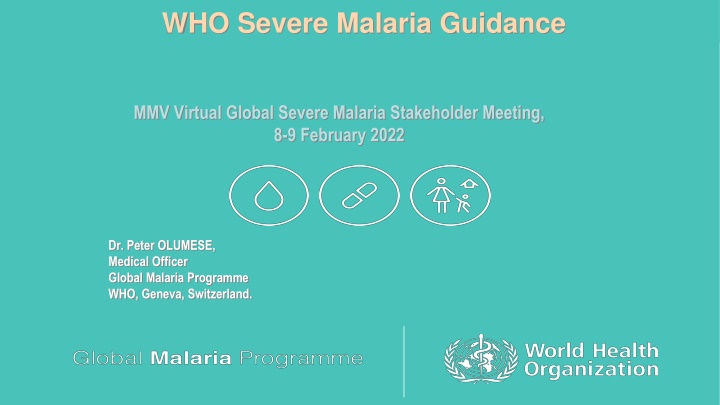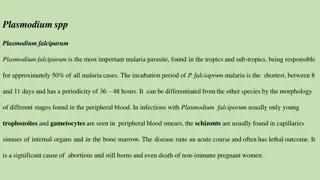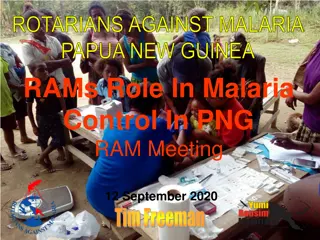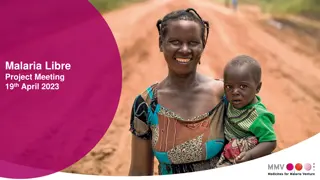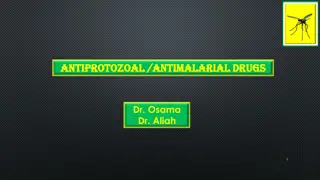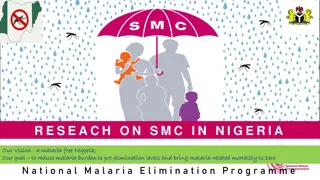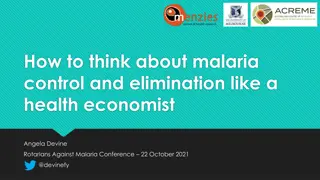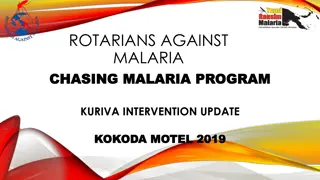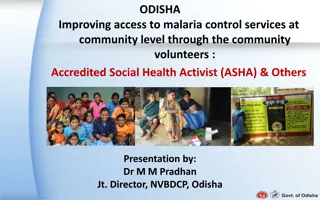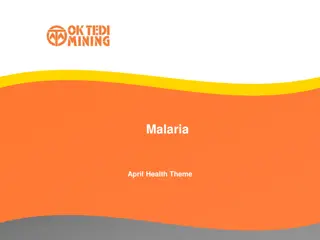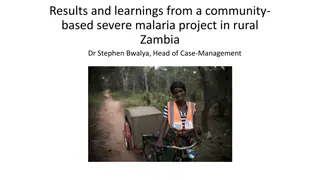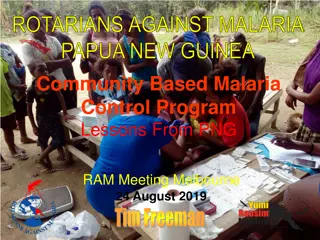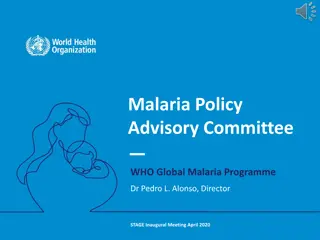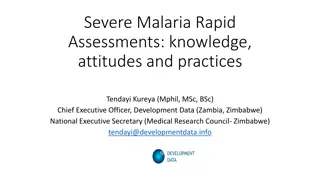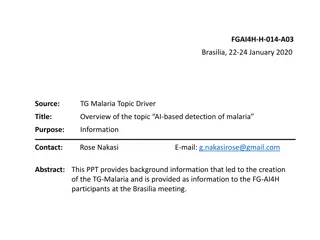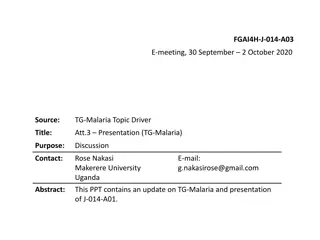Severe Malaria Treatment Guidelines by WHO
Severe malaria requires prompt diagnosis and treatment to prevent death and complications. The main focus is on achieving therapeutic concentrations of effective antimalarials quickly. Management involves clinical assessment, specific antimalarial treatment, addressing complications, and supportive care. Diagnosis should be confirmed even if immediate testing is not possible. Treatment includes intravenous or intramuscular artesunate for at least 24 hours, followed by oral medication until completion. Children weighing under 20 kg require a higher dose of artesunate. If artesunate is unavailable, artemether is preferred over quinine.
Download Presentation

Please find below an Image/Link to download the presentation.
The content on the website is provided AS IS for your information and personal use only. It may not be sold, licensed, or shared on other websites without obtaining consent from the author.If you encounter any issues during the download, it is possible that the publisher has removed the file from their server.
You are allowed to download the files provided on this website for personal or commercial use, subject to the condition that they are used lawfully. All files are the property of their respective owners.
The content on the website is provided AS IS for your information and personal use only. It may not be sold, licensed, or shared on other websites without obtaining consent from the author.
E N D
Presentation Transcript
WHO Severe Malaria Guidance MMV Virtual Global Severe Malaria Stakeholder Meeting, 8-9 February 2022 Dr. Peter OLUMESE, Medical Officer Global Malaria Programme WHO, Geneva, Switzerland.
WHO Guidelines for Malaria WHO Guidelines for Malaria (2021) These consolidated guidelines replace 2 guideline documents on the WHO website: the Guidelines for the treatment of malaria, 3rd edition (2015), and the Guidelines for malaria vector control. As new evidence becomes available, the recommendations will be reviewed and updated, where appropriate, using WHO s transparent and rigorous guideline development process. Published in February 2021; and will be updated on a living basis Available online: https://www.who.int/publications/i/item/guidelines-for-malaria
Severe malaria recommendation Therapeutic Objectives Main objective is to prevent the patient from dying Secondary objectives are to prevent disabilities and prevention of recrudescent infection Death from severe malaria often occurs within hours of onset of symptoms or admission to hospital Essential that therapeutic concentrations of a highly effective antimalarial are achieved as soon as possible Management of severe malaria comprises four main areas Clinical assessment of patient Specific antimalarial treatment Additional treatments (managements of other complications), and Supportive care
Severe malaria Diagnosis Symptomatic malaria with signs of severity or evidence of vital organ dysfunction Parasitological confirmation preferably microscopy (other advantages beyond detecting parasites) before treatment (RDT where microscopy not feasible) Early start of parenteral treatment is life-saving! Suspect severe malaria even if parasitological confirmation is not immediately possible and efforts to confirm diagnosis would delay commencement of treatment Confirm diagnosis even after administration of 1st dose of treatment
Severe malaria: Treatment Treat children and adults with severe malaria (including infants, pregnant women in all trimester, and lactating women) with intravenous or intramuscular artesunate for at least 24 hours and until able to tolerate oral medication. Once the patient has received at least 24h of parenteral therapy, and can tolerate oral therapy, complete treatment with 3 days of ACT Children weighing <20 kg should receive a higher dose of artesunate (3 mg/kg/dose) than larger children and adults (2.4 mg/kg/dose) to ensure equivalent drug blood level. If parenteral artesunate is not available, use artemether in preference to quinine for treating children and adults with severe malaria
Severe malaria: Treatment Pre-referral treatment Where complete treatment of severe malaria is not possible but injections are available, give children and adults a single dose of intramuscular artesunate and refer to an appropriate facility for further care. Where intramuscular artesunate is not available use intramuscular artemether or, if that is not available, use intramuscular quinine Where intramuscular injections are unavailable, treat children <6 years with a single rectal dose (10mg/kg) of artesunate, and refer immediately to an appropriate facility for further care. Do not use rectal artesunate in older children and adults.
Severe malaria: Treatment Pre-referral treatment Where intramuscular injections are unavailable, treat children <6 years with a single rectal dose (10mg/kg) of artesunate, and refer immediately to an appropriate facility for further care. Do not use rectal artesunate in older children and adults. *In a large individually randomized placebo-controlled trial in three countries (Bangladesh, Ghana and United Republic of Tanzania)the use of pre-referral RAS reduced case fatality of an episode by 26% and reduced death and permanent disability by about 50% in children under 6 years where referral and post referral care were provided.
Severe malaria: Treatment Pre-referral treatment: Follow-on action Refer the patient as soon as feasible to a centre where full management is available Where referral is not possible Insufficient evidence on continued rectal treatment, but recommendation based on expert opinion: Rectal treatment should be continued until the patient can tolerate oral medication, then Administer a complete course of an effective ACT
Implementation status In 2018, RAS became available at a quality-assured standard, with the WHO prequalification of two 100 mg products a key factor for large-scale procurement of the commodity using multilateral funds. Between 2018 and 2020, about 3 million WHO-prequalified suppositories procured by more than 20 countries. Several countries in the process of commencing deployment or expanding their ongoing deployment as part of community case management interventions
Background and context: The CARAMAL Project The CARAMAL study aimed to assess the impact of pre-referral rectal artesunate (RAS) under real-world conditions. By design, minimal investments were made into the overall health systems at both pre- and post-referral levels, to reflect the normal local standard. An observational study, the analysis of findings was based on an overall before-and- after analysis, and individual analysis of users versus non-users of RAS Children < 5 years presenting to a community-based health provider with a positive malaria test and signs of severe malaria were followed-up during admission and after 28 days to assess their health status and treatment
Background and context: The CARAMAL Project Main findings The CARAMAL project highlighted many challenges and deficiencies along the cascade of care, revealing health system weaknesses and inadequate quality of care. For example: Only a small proportion (< 10%) of the children enrolled in all three countries completed the full course of severe malaria treatment with injectable artesunate and an ACT. Children who received RAS received an incorrect dose for their age. Post-referral treatment was often incomplete; in particular, the required three-day ACT treatment was not consistently administered.
Background and context: The CARAMAL Project Main findings In an overall before-and-after analysis, the roll-out of RAS has not resulted in a decrease in the case fatality ratio (CFR) among children with suspected severe malaria in any of the three project countries The CFR evaluated at 28 days follow-up was higher in all countries after the roll-out of RAS (6.7% vs. 6.6% in the Democratic Republic of the Congo, 16.1% vs. 4.2% in Nigeria, 0.7% vs. 0.3% in Uganda). In an individual analysis of users versus non-users of RAS, the administration of RAS was found to (i) reduce the risk of dying in one country (Uganda) and (ii) reduce the risk of continued illness in two countries (DR Congo and Uganda), demonstrating potential benefit for child survival.
Conclusion and way forward In 2015, based on randomized controlled studies, WHO made a Guidelines recommendation for the use of RAS as a lifesaving intervention, a change or modification to that recommendation will be based on a robust review of evidence as is standard procedure of WHO. The recently published information note must be interpreted in the context of the existing WHO recommendations, therefore: RAS as a life saving intervention should be made available to all children in accordance with the guideline recommendation Strengthening of referral and post referral services should be prioritised and supported on a continuing basis RAS must not be withheld from any child where no alternative is available.
Conclusion and way forward WHO urge Malaria endemic countries to continue with implementation and scale up of malaria case management services as per their national policies and guidelines All stakeholders to ensure quality of care in line with existing WHO recommendations considering the full cascade of care with its individual required steps Countries and partners, to continue support the rational use of antimalarials to mitigate the development and spread of artemisinin resistance Funders, to support in addition to commodities, the systems required to safely and effectively deploy these interventions at the community level as part of a high quality continuum of care Manufacturers, to ensure continued supply of RAS
Conclusion and way forward Finally, WHO will continue to support and facilitate countries to strengthen their health systems to maximize the safe and effective deployment of RAS and other pre- referral medications at the community as part of the continuum of care for severely sick children
Keep our eye on the prize: a world free of malaria Thank you
